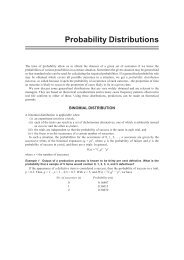International-Business-Dr-R-Chandran-E-book
International-Business-Dr-R-Chandran-E-book
International-Business-Dr-R-Chandran-E-book
You also want an ePaper? Increase the reach of your titles
YUMPU automatically turns print PDFs into web optimized ePapers that Google loves.
4. Objections raised/No objections raised<br />
5. Dealing with objections<br />
6. Grant/Registration<br />
It is a simple six step procedure that anyone can follow.<br />
184<br />
<strong>International</strong> <strong>Business</strong>- <strong>Dr</strong>. R. <strong>Chandran</strong><br />
Where an application procedure is involved, the protection ultimately<br />
obtained is usually an absolute monopoly, patents registered designs and<br />
registered trademarks fall into this category.<br />
Intellectual property rights arise automatically if an original work, such<br />
as a drawing, design document, or prototype is created. These rights are<br />
usually limited to preventing any form of reproduction of misinterpretation.<br />
Copyrights, unregistered design rights (including semiconductor topography<br />
rights) and unregistered trademarks fall into this category.<br />
CONCEPT AND MEANING OF IPR<br />
Patents<br />
Patent protection can be obtained for many types of technical innovations.<br />
For example, a new piece of apparatus or machinery to carry out a particular<br />
operation, a method or process for performing an operation or making a<br />
product or the use of a piece of equipment or product for a particular<br />
purpose.<br />
In order to determine if patent protection can be obtained, it is necessary<br />
to consider whether the technical innovation is both novel and innovative.<br />
Both these terms have a legal definition. It is usually relatively<br />
straightforward to determine if a technical innovation is novel or not. The<br />
determination is based upon whether the innovation is different from that<br />
which existed previously. It is more difficult to assess if an innovation is<br />
inventive. This determination is based upon whether it will be obvious,<br />
given what existed previously, to arrive at the invention. Unfortunately this<br />
is a legal definition, which cannot be applied without knowledge of the<br />
concerned body of case law on the subject.<br />
Patent protection is not available for every type of innovation. It is<br />
excluded in the case of innovations that are artistic and not technical<br />
innovations, and innovations that are not applicable in industry. Once again<br />
these are strict legal definitions and a thorough knowledge of case law is<br />
needed to accurately assess whether an invention is an excluded invention.<br />
Patents are obtained via an application procedure that involves a search and<br />
Only for Private Circulation





